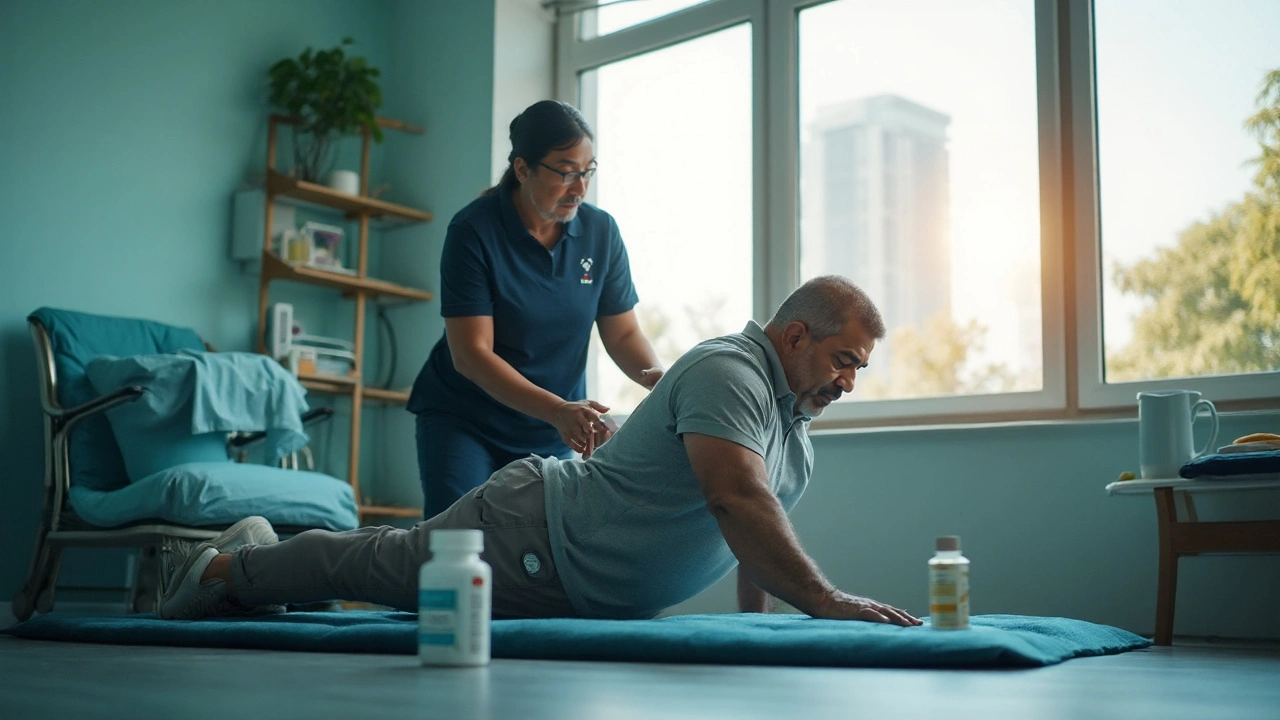Spasticity Treatment Selector
Lioresal is a brand name for the prescription muscle‑relaxant baclofen, approved to treat spasticity caused by multiple sclerosis, spinal‑cord injury and other neurological conditions. It works by binding to GABA‑B receptors in the spinal cord, dampening nerve signals that cause muscle stiffness.
Why Compare Lioresal with Other Options?
Patients and clinicians face a maze of choices when managing spasticity. The goal isn’t just to pick the cheapest pill; it’s to balance symptom control, safety, convenience and cost. By laying out the key attributes of each option, you can decide whether Lioresal fits your lifestyle or if another therapy might be a better match.
Major Pharmacologic Alternatives
Below are the most widely used oral or injectable agents that clinicians consider alongside Lioresal.
Baclofen (generic) is the same active ingredient found in Lioresal, typically sold in 10mg tablets. It offers the exact pharmacologic profile but often at a lower price point, especially in bulk.
Tizanidine is a short‑acting α2‑adrenergic agonist that reduces muscle tone by inhibiting motor neurons. It’s favored for patients who need rapid titration or who experience excessive drowsiness with baclofen.
Cyclobenzaprine is a tricyclic‑derived muscle relaxant that primarily acts on the central nervous system. It’s commonly prescribed for acute muscle spasms rather than chronic spasticity.
Methocarbamol is a carbamate‑type relaxant that can be taken orally or intravenously. It has a modest effect on tone and is often paired with physical therapy after injury.
Non‑Drug Therapies Worth Mentioning
Physical therapy is a cornerstone of spasticity management. Targeted stretching, strength training and functional exercises can reduce tone without the side‑effects of medication.
Botulinum toxin injections (commercially known as Botox) temporarily block acetylcholine release at the neuromuscular junction, offering localized relief for focal spasticity.
Side‑Effect Profiles at a Glance
Understanding what each treatment can do to your body is crucial. Below is a side‑by‑side snapshot of the most common adverse events reported in clinical practice and major trials.
| Drug / Therapy | Typical Form | Usual Dose Range | Onset of Action | Common Side‑Effects |
|---|---|---|---|---|
| Lioresal | Tablet (10mg) | 5‑80mg/day (divided) | 30‑60min | Drowsiness, dizziness, weakness, nausea |
| Baclofen (generic) | Tablet (10mg) or oral suspension | 5‑80mg/day | 30‑60min | Similar to Lioresar, but cost‑related differences can affect adherence |
| Tizanidine | Tablet (2mg) | 2‑36mg/day | 15‑30min | Dry mouth, hypotension, liver‑enzyme elevation |
| Cyclobenzaprine | Tablet (5‑10mg) | 5‑30mg/day | 1‑2h | Somnolence, anticholinergic effects (dry mouth, constipation) |
| Methocarbamol | Tablet (500mg) or IV | 1‑2g/day | 30‑60min | Drowsiness, confusion, flushing |
| Botulinum toxin | Injectable (Units) | 50‑400U per affected muscle | 3‑7days | Localized weakness, mild pain at injection site |
| Physical therapy | In‑person or tele‑rehab sessions | Individualized schedule | Immediate effect on range of motion, long‑term tone reduction | Minimal (muscle soreness possible) |

Choosing the Right Option for Your Situation
Think of spasticity treatment as a toolbox. The right tool depends on three practical questions:
- What is the severity and distribution of tone? Focal spasm (e.g., toe flexors) may respond well to Botulinum toxin, while generalized stiffness often needs oral agents.
- How does your body tolerate medication? If you’re prone to liver issues, Tizanidine might pose a risk; if drowsiness interferes with work, Cyclobenzaprine could be a poor fit.
- What are your lifestyle and cost constraints? Generic Baclofen is usually cheaper than the branded Lioresar, but insurance coverage varies across countries.
In practice, many clinicians start patients on a low dose of Lioresar or generic baclofen, titrating up while monitoring strength and side‑effects. If the optimal dose creeps above 60mg/day and side‑effects become limiting, they often switch to Tizanidine for its quicker tapering ability.
Special Populations
Multiple sclerosis (MS) patients frequently experience fluctuating spasticity. Studies from 2023‑2024 show that combining a low‑dose baclofen with intermittent botulinum toxin injections reduces relapse‑related tone spikes while keeping daily pill burden low.
Elderly adults are more sensitive to sedative effects. For them, Physical therapy plus a minimal baclofen dose (5‑10mg/day) often achieves functional gains without increasing fall risk.
Pediatric cerebral palsy cases usually start with oral baclofen early, but if growth spurt‑related tone worsens, clinicians may add intrathecal baclofen pumps-a more invasive but highly effective route. That’s beyond the scope of this article but worth noting for anyone researching long‑term management.
Practical Tips for Starting or Switching
- Discuss baseline blood pressure and liver enzymes with your physician; Tizanidine and high‑dose baclofen can affect both.
- Ask for a written taper schedule before stopping any medication; sudden withdrawal of baclofen can cause seizures.
- Track daily muscle tone using a simple 0‑10 scale; patterns help your doctor adjust doses precisely.
- Combine the chosen drug with a regular stretching routine; even a 10‑minute daily stretch can halve the required dose for many people.
- Review insurance coverage quarterly; some plans favor generic baclofen, while others have better rebates for Botox.
Bottom Line
If you need a reliable, well‑studied oral agent and don’t mind daily tablets, Lioresar remains a solid first‑line choice. Its long‑track record and predictable dosing make it a go‑to for many clinicians. But the market offers cheaper generic baclofen, faster‑acting Tizanidine, short‑term Cyclobenzaprine for acute spasms, and non‑pharmacologic options that can shave off dose‑related side‑effects. The smartest plan blends the right drug with rehab strategies tailored to your daily routine.
Frequently Asked Questions
Can I switch from Lioresar to generic baclofen without a doctor’s approval?
Never make the change on your own. Even though they contain the same active ingredient, the tablet strength, formulation and insurance billing differ. Your doctor can write a safe taper plan and ensure you stay within the therapeutic window.
Is Tizanidine safer for people with liver disease?
Tizanidine is metabolized by the liver, so impaired function actually raises its blood levels and risk of hypotension. If you have chronic liver disease, baclofen (which is mostly excreted unchanged by the kidneys) is usually the safer oral choice.
How quickly does Botox start working for spasticity?
Patients typically notice a reduction in tone within 3‑7days, with peak effect around 2‑3weeks. The benefit lasts 3‑4months, after which re‑injection is needed.
What are the key signs that my dose of Lioresar is too high?
Common red flags include excessive daytime sleepiness, new‑onset weakness that interferes with walking, or frequent falls. If any of these appear, contact your prescriber to discuss a dose reduction.
Can physical therapy replace medication entirely?
For mild, focal spasticity, an aggressive PT program can sometimes eliminate the need for drugs. However, moderate‑to‑severe generalized tone usually requires at least a low‑dose oral agent to achieve functional gains.




Yassin Hammachi
September 24, 2025 at 16:10I appreciate the thorough breakdown of Lioresal versus the other options. It’s clear you’ve put a lot of effort into the side‑effect tables and the practical tips. For many patients, the balance between efficacy and drowsiness is the make‑or‑break factor. The suggestion to combine low‑dose baclofen with a daily stretch routine resonates with my own experience. Also, the reminder about taper schedules for baclofen withdrawal is a crucial safety point.
Michael Wall
September 30, 2025 at 22:10Honestly, the article seems to gloss over the moral responsibility of prescribing cheap generics. If a patient can get a brand name for a fraction of the cost, why push them toward a "cheaper" option that may be less effective? The writer should have taken a firmer stance on patient advocacy.
Christopher Xompero
October 7, 2025 at 04:10Okay, let me break this down for everyone who thinks this is just another boring med‑review. First, Lioresal is basically the rockstar of baclofen, and it’s got a legacy that makes other drugs look like backup singers. Second, if you’re chasing that quick‑acting Tizanidine hype, remember it can drop your blood pressure faster than my internet connection during a storm! Third, Botulinum toxin isn’t just for wrinkles-it's a legit game‑changer for focal spasticity, like a sniper rifle for a specific muscle. Fourth, the side‑effects table is a masterpiece-like an Excel sheet that actually tells you something useful. Fifth, the article forgot to mention that intrathecal baclofen pumps exist, which is a whole other universe of options. Sixth, you can't ignore the cost factor; insurance can be a wild beast. Seventh, the physical therapy section could be longer-people need those daily stretches! Eighth, the dosage ranges are a bit vague; start low and go slow is the mantra. Ninth, the liver warning for Tizanidine is spot‑on-don’t be a hero and skip labs. Tenth, the article’s tone is nice but could use a bit more punch. Eleventh, I love the bullet list on choosing the right tool-very DIY. Twelfth, the risk of baclofen withdrawal seizures is real, so taper carefully. Thirteenth, the author’s mention of combining therapies is exactly what we need in real life. Fourteenth, the mention of “experimental” intrathecal pumps was missing-maybe next time. Fifteenth, the FAQ section hits the most common worries, kudos. Lastly, overall this is a solid guide, but a bit more drama would keep us all awake!
Irene Harty
October 13, 2025 at 10:10One must consider that pharmaceutical giants manipulate study outcomes to favor brand medications.
Jason Lancer
October 19, 2025 at 16:10Not bad, but the whole thing feels like a sales brochure. Could use more hard data, maybe.
Brooks Gregoria
October 25, 2025 at 22:10While you’re busy praising Lioresal as the "reliable" first‑line, you’re ignoring the fact that brand loyalty is a corporate myth. Generic baclofen does the same job for a fraction of the price, and the "well‑studied profile" argument is nothing more than a marketing ploy. If you wanted a real discussion, you’d challenge the pharma agenda rather than just list pros and cons.
Sumit(Sirin) Vadaviya
November 1, 2025 at 03:10Great overview! 👍 The step‑by‑step calculator idea is super helpful for patients who feel overwhelmed by choices. Keep the friendly tone; it really makes the info feel accessible.
lindsey tran
November 7, 2025 at 09:10Wow, this article really shines! I love how it walks you through each option like a friendly guide.
It’s not just a bland list; the tips on blending meds with PT are golden.
And that FAQ? Total lifesaver for anyone staring at a prescription bottle and feeling lost.
Seriously, thank you for making such a complex topic feel doable!
Krishna Sirdar
November 13, 2025 at 15:10When approaching spasticity management, it helps to think of the patient as a whole system rather than a collection of isolated symptoms. First, assess the severity using a standardized scale; this provides a baseline for tracking progress. Second, evaluate the distribution: focal versus generalized patterns will steer you toward either localized interventions like Botox or systemic agents such as baclofen. Third, consider comorbidities-liver function, blood pressure, and renal clearance are critical when selecting Tizanidine versus baclofen. Fourth, discuss lifestyle factors; a patient who works night shifts may find the sedation profile of cyclobenzaprine intolerable. Fifth, incorporate non‑pharmacologic strategies early – daily stretching, functional mobility training, and aquatic therapy can reduce tone without added drug burden. Sixth, if the patient’s tone is mild, a trial of physical therapy alone for 6‑8 weeks may be sufficient, reserving medication for refractory cases. Seventh, when initiating baclofen, start at the lowest dose (5 mg) and titrate by 5 mg increments every 3‑4 days, monitoring for drowsiness or weakness. Eighth, be vigilant for baclofen withdrawal; a sudden stop can precipitate seizures, so a taper plan is mandatory. Ninth, if the patient experiences intolerable side‑effects at higher baclofen doses, transition to Tizanidine, but remember to check hepatic panels weekly for the first month. Tenth, for those with focal spasticity unresponsive to oral meds, Botox injections provide targeted relief with a delayed onset of 3‑7 days and a duration of roughly three months. Eleventh, combine botulinum toxin with a structured home‑exercise program to prolong functional gains. Twelfth, in elderly patients, prioritize low‑dose baclofen (5‑10 mg) plus PT to minimize fall risk while still achieving modest tone reduction. Thirteenth, pediatric patients with cerebral palsy may benefit from intrathecal baclofen pumps when oral therapy fails, though surgical considerations are significant. Fourteenth, always align treatment goals with the patient’s personal objectives – whether that’s walking longer distances, improving hand function, or simply reducing pain. Fifteenth, schedule regular follow‑ups every 4‑6 weeks during titration phases to adjust dosing and address emerging concerns.
becca skyy
November 19, 2025 at 21:10Super helpful article – loved the clear tables and practical tips. The language is spot‑on and the advice feels realistic.
Theo Roussel
November 26, 2025 at 03:10From a pharmacology perspective, the comparative PK/PD profiles are well‑captured. The discussion on GABA‑B receptor agonism versus α2‑adrenergic mechanisms adds depth.
Erick Masese
December 2, 2025 at 09:10The article is polished and informative; however, I would have appreciated a deeper dive into cost‑effectiveness analyses across healthcare systems.
Matthew Charlton
December 8, 2025 at 15:10Great job laying out the options. I’d add that patients should keep a simple log of their daily tone scores – it makes dose adjustments with the doctor much smoother.
Pamela may
December 14, 2025 at 21:10While the article covers the basics, it completely sidesteps the reality that many patients end up on a cocktail of meds that interact in unpredictable ways. The piece could have warned more about polypharmacy risks, especially when adding a muscle relaxant on top of existing antispasmodics. Also, the tone is overly optimistic; real‑world adherence drops off when side‑effects like sedation hit hard. A more critical lens on the long‑term sustainability of these regimens would have been welcome.
tierra hopkins
December 21, 2025 at 03:10Thanks for the balanced overview! I especially like the tip about combining low‑dose baclofen with a daily stretch routine.
Ryan Walsh
December 27, 2025 at 09:10Nice breakdown – the suggestion to start low and go slow with baclofen is spot‑on. It’s also good to have the PT reminder.
Kiersten Denton
January 2, 2026 at 15:10Interesting read. The tables make it easy to compare options at a glance.